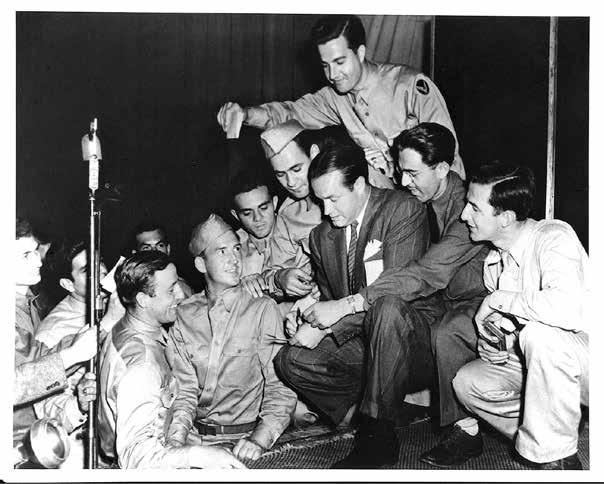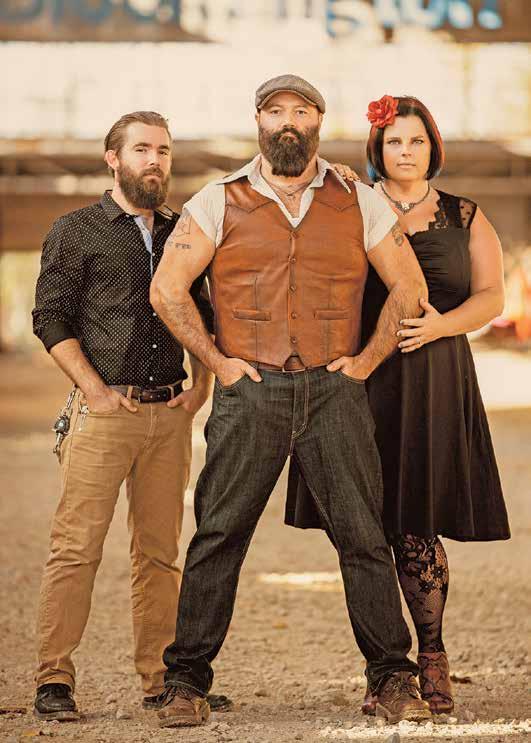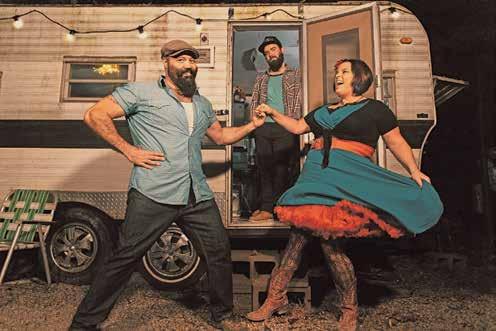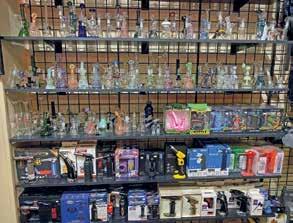
21 minute read
Dear Bob
THANKS FOR THE MEMORY
New Book Offers an Emotional Glimpse of Bob Hope’s WWII Correspondence
Advertisement
BY LEE VALENTINE SMITH
Author Martha Bolton knew the comic for years during “A NYWHERE WE WENT, WHENEVER WE landed, we would always do an impromptu show. We’d go into one of our little bits. Then we’d go to the next place. The troupe was constantly on, constantly entertaining-whether it was three people in her tenure as his first female staff writer. She wrote material for Hope’s television specials, live appearances and military shows for fifteen years, from the ‘80s until his death in 2003. INsite spoke with the Emmynominated journalist from her home in Nashville. the commissary or the entire unit.” - Bob Hope Fans of classic comedy know Bob Hope from his series of television appearances and film roles. Baby boomers fondly remember his variety specials on NBC, often highlighting his visits to war-torn areas during the Vietnam war. His travelling USO shows, with comedic foils such as Jerry Colonna and Joey Heatherton were According to the press release, you’ve written eightyeight books. That’s an impressive amount of work. Is Dear Bob your eighty-ninth project? I think it’s the 89th. It’s interesting because once you start, you don’t really realize the number. If you’re doing three books a year, it adds up. consistently highly rated TV events on NBC. But Hope had been entertaining the troops for many years before his successful ‘Nam tours. Last year, as the 75th anniversary of the end of WWII passed, an intriguing new book was being compiled. The resilient relationship between Bob Hope and “The Greatest Generation” is examined in a new collection from University Press of Mississippi, Dear Bob… Bob Hope’s Wartime Correspondence with the G.I.’s of World War II. Veteran comedy writer Martha Bolton and Hope’s daughter Linda have assembled a rare look at the personal communications between the comedic actor and the men and women who fought in World War II. Personal letters, cards and packages were traded between Hope, the troops and their families. Because of his live appearances and radio shows, he became a vital link to home for many military members. Long before email and texts, a letter was the main method of communication for the deployed vets. In a press release, writer-producer Linda Hope, Bob’s eldest daughter, explains, “The people back home loved hearing something from a base from where one of their loved ones was stationed. Handwritten letters were That could fill an entire library. Do you display them all in order? Right now, I’ve them sorted by size, I haven’t put them in order yet. But it’s from a long career. I have a biography that’s pretty much spread out over the course of doing all these books. What a legacy of work and it mirrors Bob Hope’s lasting heritage as well. He was a true pioneer of television, film and even stand-up comedy. Exactly. He’s credited with being one of the first stand-up comics. It was just him and the microphone. People latched on him as a touchstone of a number of different genres. The book shows that bond in great detail. That’s right and he was aware of it, too. He kept upto-date with all the generations. When he’d do a show, he’d have the legends on, but he’d also have the up-andcoming stars too. The hottest stars of the day, no matter what day it was. He was very deliberate about that and he had fans that just couldn’t get enough of him, or do enough for him, because of that connection. ANYWHERE WE WENT, WHENEVER WE LANDED, WE WOULD ALWAYS DO AN IMPROMPTU SHOW. cherished. Dad received an average of 38,000 letters a week. He would often dictate responses to be typed and mailed off by his secretary. The letters were amazing. They had to deal with a variety of topics, asking when they were going to be coming home, could they visit with him on the set or meet Lana Turner or Rita Hayworth.” Though many of the letters frequently contained lighthearted banter, some were much more serious. Families of fatally wounded GIs would often write to Hope. The grieving relatives would note that the last thing they heard from their loved one was that they had You can definitely see that admiration in the letters. That was our goal, to bring out we saw in the letters. It became very evident that this wasn’t a typical celebrity/ fan relationship. It was far more than that. These were friends. They called him the GI’s best friend and he really was. They could tell him anything, they could ask for anything and he’d do his best to send it. They’d tease him and he’d tease them right back. It went beyond anything any usual celebrity interactions with fans, before or since. They were like family to him. seen his show and were thankful he had given them a bit of a distraction from the war. Dear Bob… resonates with the pathos of battle and the humor of an era. The communications remain as stirring today as they were when Hope received - and meticulously saved - each letter. Now preserved at the Library of Congress, the thoroughly entertaining volume offers a rare perspective on the fragile, funny and often heart-wrenching correspondence. Even more remarkable is this wasn’t like today’s instant-gratification, electronic communication, it was old-fashioned snail mail. Equally impressive is the fact that he actually kept the letters and replies. That was some thorough bookkeeping by his secretary. Right, I believe his secretary Marjorie Hughes had the foresight to know that this was going to be of historic significance. Not only did she keep the soldiers’ letters, she saved Bob’s responses on onion-skin carbon copies. She saved it all, the air-letter and Bob’s response. At the height of the war, he was receiving 38,000 fan letters a week, can you imagine? He did his best to answer as many as he could. The soldiers, when they’d receive it on their end, not only did it make their day, but the other soldiers would follow them back to their tents so they could pass it around. Then they’d send him souvenirs from wherever they were stationed. It wasn’t like today’s instant mail, sometimes the letter would follow the soldiers around and it could take weeks, months or even years to get to them. It was a whole different world then - you could go weeks or months without hearing any news from your family. On his tours, soldiers would sometimes slip him telephone numbers of their family and ask that he call them. When he got home, he’d sit by the phone and go through them one by one. ready to laugh they became his favorite audience and he started doing his radio show at military bases. He’d say something like, ‘Just drop me a line, and it started organically.

It grew fast to get up to nearly 40,000 a week. It did and the responses are so touching. You see some that say, ‘This is the first fan letter I’ve ever written and you’ll probably never read it.’ But he did! It’s touching to see the level of gratitude that really comes through on the pages. He gave them Hope.
Literally. And you knew him personally. What was he like as a boss? I did. It was a pleasure to know him. I wrote for him for fifteen years and he never said an unkind word to me in all that time.
Growing up, I thought of comedy show writers as they were depicted on The Dick Van Dyke Show, but you were writing for Bob in the ‘80s. The times had obviously changed. When he’d have his television specials, we’d meet at his house and talk about what the show was going to be about, different sketch ideas. Then we’d go home and do our versions of what he wanted. Then he would put it all together, sometimes taking some or all of a sketch, sometimes combining them. For the monologues, he’d call us and give us topics or ask for our ideas. When we’d read the news, we could usually tell what could become a good Bob Hope joke.
He famously used cue-cards on television. Did he ever memorize any of his bits? He used the cards on television, but when he was on the road, he’d call and we’d give him lines. Then he would go straight onstage and do them, having just heard ten or fifteen jokes on the phone. I don’t know how he did it. He must’ve had a photographic mind. In WWII, when he did his USO shows, he’d have a writer along with him and a team at home. They’d give him new jokes for wherever he was and he’d go right out onstage and do them all, no cue-cards. The man had a memory.
MUSIC FOR NOW
Reverend Peyton’s Big Damn Band Rocks the Blues
BY REVEREND L.V. SMITH
IF YOU THOUGHT YOUR 2020 WAS bad, it could’ve been worse. Just ask Reverend Peyton. The leader of the Big Damn Band had a particularly trying time. In addition to the general malaise of the pandemic, the Reverend’s wife, the vivacious “Washboard” Breezy Peyton and one-third of the band, suffered a long and debilitating ailment and his father was enduring cancer treatments. Then the volatile weather of rustic Southern Indiana knocked off the electricity at the Peytons’ 150-year-old log cabin for days. But the good news is, being an astute bluesman, Rev used his pain and worry for inspiration. The results are released this month as the basis of his latest album, Dance Songs for Hard Times (Family Owned Records/Thirty Tigers). Written mostly by candlelight during the blackout and recorded with the finest retro equipment in Nashville. Captured by Grammy-winning producer Vance Powell, the front-porch blues band rocks and wails with vibrant abandon. Highlights of the eleven selections include the pertinent, captivating and wholly appropriate “No Tellin’ When,” “Come Down Angels” “Ways and Means” and “Too Cool to Dance.” As 2020 progressed, Breezy recovered and the Reverend’s father was declared cancer-free following surgery. The band, completed by Max Senteney on drums, hasn’t toured in a year but they’ve maintained a regular schedule of popular livestream performances that originate from the rustic cottage. INsite spoke with the gregarious singersongwriter by phone from his Brown County, Indiana studio.
The album turned out great, even though some especially hard times inspired it. I appreciate that. It’s hard to convey just how proud we are of it. I always tell people that I don’t think my best record has been made yet. Every time you hear a new record from me it’s gonna be better than the last one. But I do think one is a major jump forward for us. I don’t know how many artists probably tell you that, but honest to God, I work on stuff every day and I try to be better, every single day, than the day before. Not just with music, but everything. I have this belief that if you aren’t getting better, you’re getting worse. So you have to fight it. Everything single thing we do as human beings, the Earth is tryin’ hard to turn it into rust and dust. Including us! So that’s why I keep working at it.

You certainly rose to the occasion. I had some songs that I was proud of so I was determined that we do them as good as we could. I really think we did it without betraying who we are and what we’re all about. One thing about it, it’s all us. We didn’t bring in anybody, we just did it live to eight-track analog tape.
The way God intended rock and roll to be recorded. Absolutely. I told Breezy, I want to try it one more time like this but I didn’t want to produce it myself. I got to talking with Vance and I just loved his vibe. I loved what he wanted to do with it. He wanted to do it on sixteen tracks, but I said, ‘No let’s just go with eight.’ That’s takin’ it way back. But he understood what we wanted and he didn’t want to change us. He just wanted to capture us live. That made me excited because I knew he trusted us. I don’t think we didn’t let him down. I could just pony right up to the microphone with my guitar - because I sang and played at the same time - and just be myself. It felt good because I knew he wasn’t gonna try to make it something it wasn’t. We were in good hands. I knew he wasn’t going to come in and add horns or electronic drums or something crazy like that.

With seven full-length records under your belt, it’s not easy to sound fresh. Yeah, plus the Record Store Day stuff and EPs, so it’s a lot of stuff. We’re gettin’ pretty deep into it now. But I still feel like we’re gettin’ better as we go along. We’ve spent the last few years doing a lot of festivals and blues cruises with Taj Mahal, getting to hang out with him and his band and crew. One thing about him that really inspires me is that whatever he does, it’s always the blues. It’s always Taj Mahal, no matter how he does it. So that has inspired me to do whatever I want to do that feels cool to me. If I think it’s cool and awesome and it’s what I want to put out into the world, then so be it. It’s from me. Take a song like “Too Cool To Dance.” It’s one of the songs on this record that I’m most proud of. At face value, it sounds like a song that might have gotten lost from 1956 or something. But all of that guitar is me, live. All the bass, all the lead. It’s all me and it’s all played live. If somebody would say, ‘Well it’s not really country blues, it’s more like Chuck Berry,’ I’d have to disagree. I’m still playin’ finger-style and I still think it sounds like us, even though it’s a little different. But that’s the challenge. There’s only so many notes and a there’s a whole lot of guitars out there.
Besides being ordained reverends, we both started out with old Kay guitars. The only difference is, you got better and better and I never progressed at all. (Laughs) I tell you what man, that first Kay I had made my hands strong. It was hard to play. I still play a Kay almost every day. I’m using one on “Too Cool To Dance.” But I sold my first one to buy a better guitar. Not too long ago, the guy I sold it to reached out to me. He said, ‘I still have your first guitar and I’d like to give it back to you.’ He’d kept it for years. So he gave it back to me and I gave to back to my dad for Father’s Day a couple of years back. Now he’s got it hangin’ up in his house, that old Kay. I spent a whole lot of time with that thing.
How long did the guy keep it? Let’s see, I’ll be 40 in April – I don’t even know where the last ten years even went – so he must’ve had it for at least twenty-five years. My dad was so surprised to see it. He thought I’d found one like it, but I said, ‘No, this is the one you bought for me!’
Tell us a bit about the title of the new album. We call it Dance Songs for Hard Times because ninety percent of it was written in a very short time, during the beginning of the pandemic. From the end of March to the beginning of April, when things were at their darkest, gloomiest and nobody knew what was gonna happen.
The unknown factor of it was the scariest part. Totally freighting. Breezy was sick and she just wouldn’t get well. We never got confirmation if she had the Coronavirus, but she had a 102 temperature for three weeks. I was the first one that got sick, but she got the worst of it. Our last show was March 11 and she was sick, but the show must go on. No one knew how widespread this thing was at the time. The next day, I took her to the hospital and they sent her back home. I was afraid to go to the grocery store or anywhere because I didn’t want to spread it around. So while we were here quarantining, the power went out. She couldn’t even get out of bed. During that time, I was writing. One night she finally felt like getting up and I played a little concert for her by candlelight. I played all these new songs I’d written while she had been so sick. She said, ‘These are the best songs you’ve ever written in your whole life.’ So I worked on honing ‘em down and sent them to Max who was up in southern Illinois. We only had one real rehearsal before went to Nashville to record them. We all had to get to tests and be extra careful in the studio because Vance was really taking it seriously, too. We pretty much lived in his studio, which was weird. Breezy cooked for us. To be in Nashville and not go to any restaurants was different but that’s how we had to do it. We just got right to work and put it all down - really quick and dirty. But I’m sure glad we did because I just felt like it was the time to do those songs. This is music for now. Right now. I just can’t wait to get back out and play these songs for everybody.



Since 1996
Over 10,000 DVD’s for Sale & Rent!
62 Channel Hi-Def Video Arcade is OPEN 24 HOURS!
Southern Nights Videos & Gifts

Social icon
Circle
Only use blue and/or white.
For more details check out our Brand Guidelines.
@SNVAtlanta
Southern Nights
2205 Cheshire Bridge Rd. 404-728-0701 • Open 24/7 www.SNVOnline.com
CHESHIRE BRIDGE TARA MOVIE THEATRE
SOUTHERN NIGHTS
WOODLAND
Atlanta’s Smoke Superstore and More... FIND IT ALL HERE!
Detox
Scales and Pipe Cleaners


Handpipes and Waterpipes
Vapes, E-cigs, and Juices


Incense
Cigars, Cigar Accessories, Specialty Cigs
Grinders
Album Reviews
REVIEWS BY JOHN B. MOORE
Cheap Cassettes
See Her In Action! (Rum Bar Records)
Seattle-based trio Cheap Cassettes turned in a phenomenally addictive album in 2017 with All Anxious, All The Time, and since then have been slowly dripping out singles via 7” s and digital releases. Their latest, the 5-song See Her In Action!, is a physical CD release of a 2019 effort by the same name, along with two new live cuts. This set, as frustratingly brief as it may be, encapsulates all that is great about this group: the frenetic energy of power pop, the unpredictability of a group like The Replacements and the sheer, unabashed enjoyment of a band like Cheap Trick. The EP’s three studio tracks include the opening title song, the equally poppy “Only Lovers Left Alive,” and the two -minute hit and run “Lil’ Bit of Everything.” The set also includes an appropriately sloppy, but no less great cover of The Replacements’ “Valentine” and a live version of “Red Line Blue,” a new Cheap Cassettes song that has yet to show up on a studio album. See Her In Action! is a stellar placeholder until the band gets around to record another LP, and that effort could not come soon enough. Jason Ringenberg Rhinestoned (Courageous Chicken) As fontman of Jason & the Scorchers, Jason Ringenberg, along with bands like The Blasters, Lone Justice and Drivin’ N’ Cryin’ helped pioneer that potent blend of punk rock and country. As a result, they laid the foundation for everyone from Old 97s and Nashville Pussy to Mike Ness’ entire solo career. It’s been decades since Jason & the Scorchers last put out a record, but Ringenberg has managed to carry his career into two seemingly divergent, but just as interesting paths over the years. He’s put out four albums as Farmer Jason – a gleeful eclectic children’s musician - and put out half a dozen solo efforts in similar vein to the music he played fronting The Scorchers. His latest solo album, the sublimely titled Rhinestoned is easily one of his best. His distinctive vocals - a wild sound that is created by taking a guy from Southern Illinois and having him live in Nashville for decades - are front and center, outshined only by his stellar lyrics, that can straddle the line between witty (“Nashville Without Rhinestones”) to poignant (“The Freedom Rides Weren’t Free”). The mix of topics here are all over the place making for a scattered, idiosyncratic and deeply fun listen. He does an addictively catchy, rocked up version of “Christ The Lord Is Risen” that had the song stuck in my Atheist head for days. Surprisingly, the album was one Ringenberg didn’t set out to make this soon, but the global pandemic shifted everyone’s plans and gave the singer plenty of time at home, with nothing to do but write music. “I was faced with the same decisions everyone else in the world faced: how to connect with folks in a disconnected world. I decided to create a new record,” he said. Rhinestoned was birthed in masks and social distancing.” The Luka State Fall In Fall Out (AntiFragile Music) The English four-piece The Luka State are proving that guitar rock – despite countless of obits that have been written about its demise – is far from dead. On their bombastic, guitars-to-11 debut, Fall In Fall Out, the band are fighting the good fight for rock music with machine gun drumming and feet on the distortion pedals. The result is an impressively lively collection of a dozen tracks (including the minute-long seemingly one note “Outro”). The band does run the risk of sounding redundant on a couple of tracks, but those moments are few and far between. Songs like “Kicked in the Teeth,” which perfectly shows off Conrad Ellis’s range as a vocalist, and tracks like “Fake News” and “Girl” brings to mind a time when bands like Fall Out Boy still played pop punk music. The band is not exactly forging new ground on their debut, but rather are reminding us about a well-trodden path that leads to music being fun again, spiked with driving bass lines, thundering drums and ear ringing guitars. Alice Cooper Detroit Stories (Alive/earMusic) Alice Cooper is certainly no stranger to concept albums; just look at Welcome To My Nightmare, Alice Cooper Goes To Hell, From The Inside… hell, just say listen to half of Cooper’s 1970s output and you realize he digs a theme. So, it shouldn’t come as that big of a surprise that his latest, Detroit Stories has a strong thread throughout connecting all of the tracks. Taking inspiration from his hometown - the city that embraced Cooper and his band long before anyone else would - he pays tribute to the Motor City in a raucous, endearing loyal album. The set kicks off with an inspired take on Lou Reed’s “Rock & Roll,” complete with a Detroit shout out in the first verse. The album continues with 14 more tracks all paying homage to that distinct 1970s Detroit hard rock sound, a scene that launched everyone from The Stooges to MC5. He also covers, fittingly, Bob Seger’s “East Side Story” and the MC5’s “Sister Anne.” Elsewhere, Cooper’s trademark dark wit and snark are showcased on songs like “Hail Mary” and “I Hate You.” At 15 tracks, not everyone here is a keeper, (“Drunk And In Love” sounds like one of Cooper’s 1980s strays) but taken as a whole, this is one of his best records in years. With this obvious nod to nostalgia, it seems fitting that Cooper brought back Bob Ezrin to produce – a legend responsible for working on some of Cooper’s best, early records, as well as albums from Aerosmith, Kiss, Pink Floyd, Nine Inch Nails among many, many others. He also brought in Detroit greats like Wayne Kramer (MC5s) and Johnny Badanjek (Detroit Wheels) to serve as part of his backing band. The guitar-heavy sound and the lyrics here certainly sound like a throwback, but that’s essentially the point. It’s easy, and lazy, to write off musicians that have been around for decades as dinosaurs, but there’s a reason why people still listen to songs like “Welcome To My Nightmare” or “Only Women Bleed,” almost five decades after they first came out – they’re amazing songs that sound just as good now as they did a generation ago. It’s hard to picture many of the biggest songs of the past few years aging this well over the next few decades.





